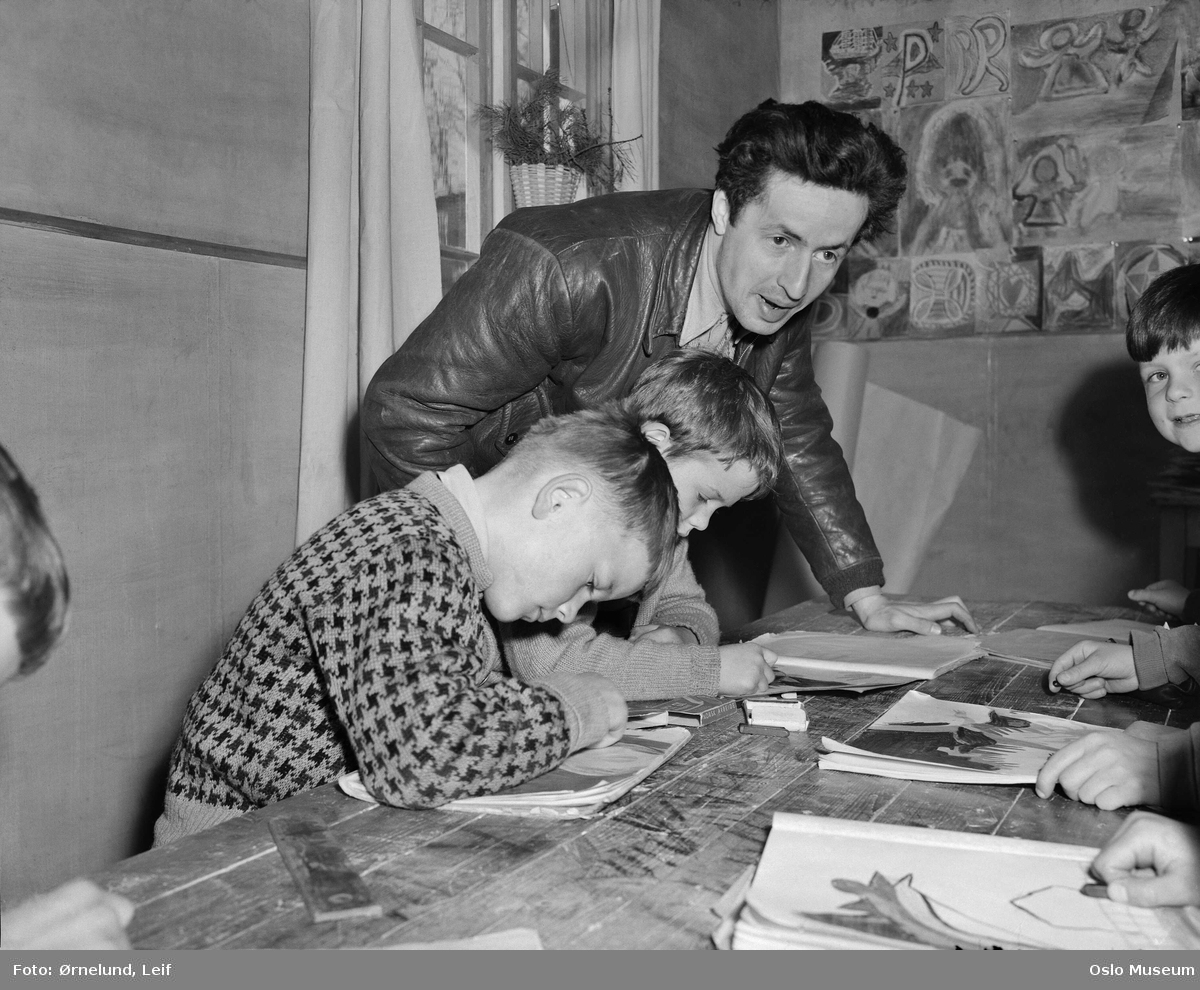Nordic non-fiction in the twentieth century
Non-fiction can include essays, reports, memoirs and biographies, and travel writing, although the boundaries of what constitutes 'non-fiction' - or, as it is called in the Scandinavian languages, 'factual prose' - are fluid.

The Scandinavian languages, unlike English, describe this category of writing in non-negative terms, as sakprosa/sagprose, ‘factual prose’. The boundaries of the category can be fluid, often causing problems with lines of demarcation. In Norway, non-fiction is a very well-researched field, with major research projects both in the 1990s and the 2000s. In Sweden a big project brought the field to prominence in the 2000s, while research in the other Nordic countries has been more piecemeal.
The essay
A long-established genre in all the Nordic countries, the essay continued to flourish after the Second World War. A leading Swedish practitioner was Frans G. Bengtsson (1894-1954), whose formal elegance was inspired by the essay form in English literature. Significant essayists in Finland include Sven Willner (1918-2012) and Harry Järv (1921-2009), with the texts of both focusing on literature. In Denmark authors such as Elsa Gress (1919-1988), Knud Sønderby (1909-1966), Hans-Jørgen Nielsen (1941-1991) and Suzanne Brøgger (b. 1944) have published essays, with the work of Brøgger providing striking examples of the fluid boundaries of this – and other – genres. The Swedish writer Kerstin Ekman’s Herrarna i skogen (2007) (The Gentlemen in the forest) is a volume of essays extending to well over 500 pages, its critical investigation into the role of the forest in Swedish culture and economy since the Middle Ages linking it to her predecessor Elin Wägner’s (1882-1949) pioneering essay on environmentalism, Väckarklocka (1941) (Alarm Clock). The Finland-Swedish philosopher Georg Henrik von Wright in several volumes of essays called into question the impact of technology in twentieth-century Western society.

Reports
Books about environmental issues were an important part of the texts which were designed to raise debate published in the Nordic countries, especially in the 1960s and 70s. Georg Borgström (1912-1990), who was Swedish but spent part of his career in the US, warned about humankind’s attitude to finite resources, e.g. in The Hungry Planet: The Modern World at the Edge of Famine (1965), and Göran Palm (b. 1931) shone the light on the exploitation of the developing countries by the industrialised world in En orättvis betraktelse (1966) (As Others See Us, 1968). In Norway Sigmund Kvaløy (1934-2014) highlighted the environmental crisis in Økokrise, natur og menneske: Enn inføring i økofilosofi og økopolitikk (1973) (The ecological crisis, nature and humankind: an introduction to ecophilosophy and ecopolitics). Jan Myrdal’s (from Sweden) politically and ideologically focused Rapport från en kinesisk by (1963) (Report from a Chinese Village, 1966) quickly achieved international fame, while Sara Lidman’s (also from Sweden) investigation into conditions in the iron mines in Kiruna in Gruva (1968) (Iron ore mine) has been linked to the strike that hit the state-run mining company a year later. Finnish Marja-Leena Mikkola’s (b. 1939) volume Raskas puuvilla (1971) (Heavy cotton) details interviews with low-paid women workers in a cotton factory; and another book of interviews by Mikkola, Menetetty lapsuus (2004) (Lost childhood), develops a critical dialogue with Finnish history as it focuses on the Finnish concentration camps for the Russian inhabitants of Petrozadovsk in Karelia during the Second World War.
The report genre was widely used by second-wave feminists throughout the Nordic countries. The boundary between this genre and the documentary novel is sometimes porous, as in the Danish writer Grete Stenbæk Jensen’s (1925-2009) Konen og æggene (1973) (The woman and the eggs), which draws on the author’s experience of packing eggs in a factory and a diary kept at the time; and a work by another Danish writer, Vibeke Vasbo (b. 1944), Al den løgn om kvinders svaghed (1976) (All those lies about women’s weakness), which not only details the experiences of a woman crane driver in Oslo but also includes advice for women wanting to write about their lives.
Memoirs and biographies
Memoirs and biographies have long been a significant genre in the Nordic countries, but such books have been published in growing numbers since the 1990s, especially in Norway. Examples are Fredrik Wandrup’s Jens Bjørneboe. Mannen, myten og kunsten (1984) (Jens Bjørneboe. The man, the myth and his art); Kjartan Fløgstad’s Portrett av eit magisk liv. Poeten Claes Gill (1988) (Portrait of a magical life. The poet Claes Gill); and Liv Køltzow’s Den unge Amalie Skram. Et portrett fra det nittende århundre (1992) (The young Amalie Skram. A portrait from the nineteenth century). The problematisation of the boundary between biography and fiction is a common feature of many modern biographies published in the Nordic countries.
Travel writing
Travel writing is represented by, among others, the Swede Sten Bergman (1895-1975), who travelled to Kamtjatka in the 1920s and Papua New Guinea in the late 1940s, when the latter region was still a Dutch colony. He wrote a number of books about his experiences, including Min far är kannibal (1959) (My father is a cannibal, 1961). The Norwegian explorer Thor Heyerdahl (1914-2002) achieved international fame with books such as Expedition Kon-Tiki (1948) (The Kon-Tiki Expedition, 1950), about a sea-crossing from South America to Polynesia on board a basic raft, designed to prove that part of Polynesia might once have been peopled by this route; and Ra (1970) (The Ra Expeditions, 1971), the account of a trip on board a papyrus boat from Africa to America. Travel writing is also an important part of the output of the Danish writer Carsten Jensen (b. 1952), e.g. Jeg har set verden begynde (1996) (I have seen the world begin, 1999).
This article has been published posthumously.
Further reading:
- Boel Englund and Per Ledin, eds., Teoretiska perspektiv på sakprosa. (Theoretical perspectives on non-fiction) (Lund: Studentlitteratur, 2003).
- Egil Børre Johnsen and Trond Berg Eriksen, eds., Norsk litteraturhistorie. Sakprosa fra 1750 til 1995 [Norwegian literary history. Non-fiction from 1750 to 1950] Vol. II. (Oslo: Universitetsforlaget, 1998).
- Poul Houe and Sven Rossel, eds., Documentarism in Scandinavian Literature. (Amsterdam and Atlanta: Rodopi, 1997).
- Arne Melberg, Resa och skriva. En guide till den moderna reselitteraturen. [Travel and write. A guide to modern travel literature] (Gothenburg: Daidalos, 2006).
- Clas Zilliacus, ed., Finlands svenska litteraturhistoria (Finnish-Swedish literary history) Vol. II. (Helsinki and Stockholm: Svenska litteratursällskapet i Finland and Atlantis, 2000).
